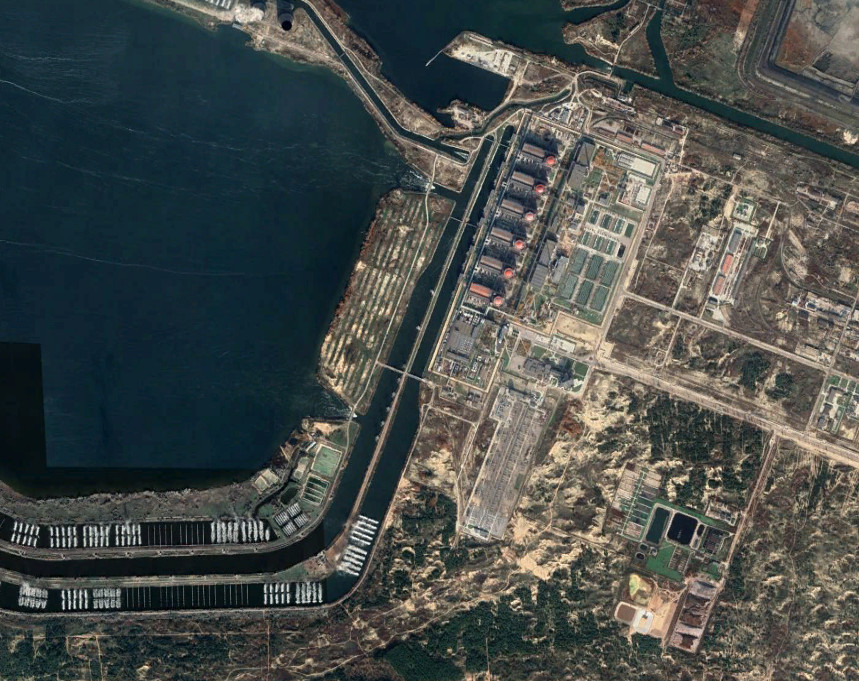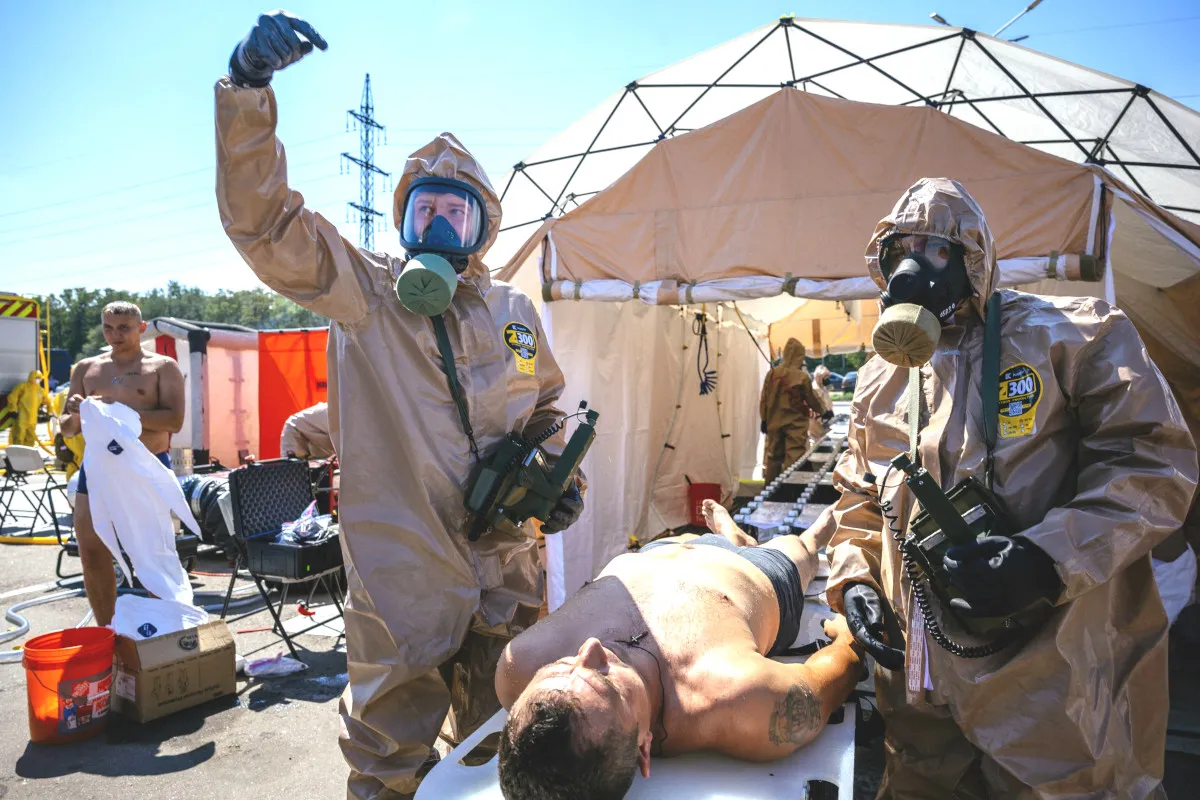Video footage has emerged online that near-conclusively shows Russian military trucks parked inside a turbine hall at the Zaporizhzhia Nuclear Power Plant in southeastern Ukraine. This comes as officials in Russia and Ukraine have been accusing each other today of preparing to stage a provocation of some kind at the facility tomorrow. Fears have been growing for weeks now of the potential for nuclear disaster at Zaporizhzhia, which the Russians have turned into a forward operating and fire support base, which could have broader impacts across Europe.
The video in question is undated and, given the often low and awkward angles in which it was shot, looks as if it may have been taken surreptitiously. At around the 0:25 mark in the 40-second-long clip, which is seen in the @intelcrab’s Tweet below, at least five trucks with large “Z” markings are visible, as well as what may be stacks of crates. Z is one of a number of different letters and other markings that Russian units have been painting on their vehicles to help them quickly identify each other on the battlefield, and that have now become broader symbols of support for the country’s war on Ukraine. There has been speculation that the apparent crates next to the trucks could be filled with ammunition, among other military supplies, but there’s no way of telling from the footage.
Experts and observers have pointed out a number of key details elsewhere in the video that nearly proves without a doubt it was taken inside one of Zaporizhzhia’s turbine halls. The elongated warehouse-like buildings house the turbines that turn the steam generated by the adjacent reactor plants into electricity. Zaporizhzhia, which is the largest nuclear power plant anywhere in Europe and is one of the ten largest such facilities in the world, has six separate reactors with their own associated turbine halls.

The video would fit with reports, based on recent satellite and other imagery of Zaporizhzhia, that have indicated that turbine halls and other buildings at the plant are or at least have been used at times to store vehicles and other materiel. Ukrainian officials, as well as their counterparts in the United States, say the Russian military has been using the site as a firebase for artillery strikes on targets in the surrounding area and as a general forward operations base, all while exploiting the ‘nuclear shield’ it offers against counterattacks. For its part, the Russian military claims it only has a small contingent there to provide basic security, despite the clear evidence to the contrary.
This new video evidence that the Russians are storing vehicles, and potentially ammunition or other hazardous material, inside at least one building next to one of Zaporizhzhia’s reactors can only underscore concerns about risks associated with the ongoing occupation of the plant. Officials in Russia and Ukraine have already been accusing each other of shelling and otherwise attacking the plant and surrounding areas on and off for weeks now. Last month, there was at least one very limited and precise Ukrainian attack on Russian personnel at the site, which was carried out using a Polish-made Warmate loitering munition, or “suicide drone.”
On top of all that, earlier today, the Russian Ministry of Defense accused the Ukrainian government of planning, together with its American “handlers,” to carry out an operation to fabricate a “minor accident” that could cause a radiation leak.
Ukrainian authorities have denied these accusations and have countered by saying that it appears the Russians made be about to stage some kind of false flag incident. Ukraine intelligence officials further alleged that Russia’s state nuclear company, Rosatom, which has representatives at Zaporizhzhia, told them, and potentially other workers at the plant, not to come in tomorrow without any apparent explanation.
The Russian government, as well as pro-Russian separatists in Eastern Ukraine, certainly do have a history of staging provocations, including a number of fabricated incidents in the run-up to the all-out invasion of the country earlier this year. Entirely unsubstantiated Russian claims that the Ukrainian government, together with the United States, was planning to launch chemical or biological weapon attacks persisted even after the invasion began, prompting concerns about false flags that might have provided a pretext for the Kremlin to authorize retaliation in kind.
Ukrainian authorities had themselves warned earlier this year that the Russians might have been considering staging some sort of incident at the now-defunct Chernobyl nuclear power plant, the site of the most serious nuclear disaster to date. Russian forces left the Chernobyl site and surrounding areas in April as part of broader withdrawals across northeastern Ukraine.
Thankfully none of these other allegedly planned incidents came to pass. Whether or not anything happens tomorrow, or in the near future, at Zaporizhzhia remains to be seen.
The Russian Ministry of Defense claimed today that a major disaster at Zaporizhzhia could see potentially dangerous amounts of radiation spread as far away as Germany. Ukrainian authorities have separately said that countries as far north as Estonia and west as the Czech Republic could be impacted.
Yesterday, the Ukrainian Emergency Ministry did hold a nuclear incident exercise in the actual city of Zaporizhzhia, which is situated some 35 miles to the northeast on the opposite shore of the Dnieper River, in light of deepening concerns about the situation at the nuclear power plant.

There of course could be other explanations for Russia’s new allegations and the surprise ‘day off’ for a least some workers at Zaporizhzhia. For one, Russian authorities have now threatened to shut the plant down entirely, ostensibly due to damage from purported Ukrainian attacks and other security concerns, which could have significant impacts on the availability of electricity in the country.
In addition, the International Atomic Energy Agency (IAEA) has been seeking access to the plant for some time now to conduct an independent assessment of the situation at the site. Ukrainian President Volodymyr Zelensky said today that he had reached an agreement with U.N. Secretary-General Antonio Guterres, who is currently visiting the country, about parameters for future IAEA visits. Ukrainian authorities have opposed previous unilateral Russian offers to facilitate IAEA trips to Zaporizhzhia. With the possibility that the first of these U.N.-sponsored visits might now be imminent, the Russian military could be looking to move its forces or otherwise conceal its presence at the plant.
“Particular attention was paid to the topic of Russia’s nuclear blackmail at the Zaporizhzhia NPP [Nuclear Power Plant],” Zelensky wrote in a post on the social media network Telegram after his meeting with Guterres. “This deliberate terror on the part of the aggressor can have global catastrophic consequences for the whole world.”
Zelensky also warned today that the situation at Zaporizhzhia could turn into “another Chernobyl.”
The Russian government has so far resisted calls from the Ukrainian government, the United Nations, and the Europe Union, among others, to withdraw completely from the site. As long as Russian forces continue to occupy it, there will continue to be a least some risk of a potential nuclear disaster due to the ongoing fighting in the country.
Contact the author: joe@thedrive.com
